Mazda Tuning
Mazda Speed 3 Tuning: Enhancing the Performance of Your High-Performance Hatchback
Maximize your Mazdaspeed3’s power and performance with essential tuning tips that will leave you eager to discover more enhancements for your hatchback.

Tuning your Mazdaspeed3 can turn it into a real powerhouse. You'll eliminate factory throttle limitations and boost performance by 18-30 HP with just a simple ECU tune. Upgrading to a high-flow air intake and performance exhaust system can add even more horsepower. You'll also enjoy features like launch control for a competitive edge. Plus, tools like VersaTuner make the tuning process quick and easy, taking less than an hour. With a few solid modifications, you can enhance throttle response and overall handling. Stick around, and you'll discover even more ways to maximize your hatchback's performance.
Key Takeaways
- Tuning the Mazdaspeed3 removes factory throttle limitations, enhancing acceleration and overall performance significantly.
- Upgrading the ECU boosts power by 18-30 HP using 91 octane fuel, improving top-end performance.
- Essential modifications include a high-flow air intake and performance exhaust system for increased horsepower and improved airflow.
- Installing high-performance intercoolers lowers temperatures and maximizes boost efficiency for better engine performance.
- Utilize user-friendly tools like VersaTuner for quick ECU flashing, completed in under an hour for optimal tuning results.
Benefits of Tuning Your Mazdaspeed3
Tuning your Mazdaspeed3 offers a multitude of benefits that can greatly enhance your driving experience. One of the most notable advantages is the elimination of factory throttle limitations at 4000 RPM. By removing these restrictions, you'll notice improved top-end acceleration and overall performance, allowing your turbocharged engine to truly shine.
With ECU tuning, you can increase boost levels, revealing impressive power gains. You might see an additional 18-30 horsepower when using 91 octane fuel, making your drives even more exhilarating.
Plus, tuning adds features like launch control and no lift shifting, which considerably elevate the dynamics of your driving experience.
Removing SWAS torque limits during shifts leads to faster, smoother gear changes, which is essential for maximizing performance.
Best of all, the tuning process is user-friendly and can be completed in under an hour, so you don't need technical expertise to optimize your Mazda.
With these enhancements, you'll not only enjoy a noticeable increase in performance but also a more engaging and enjoyable driving experience every time you hit the road.
Essential Performance Modifications
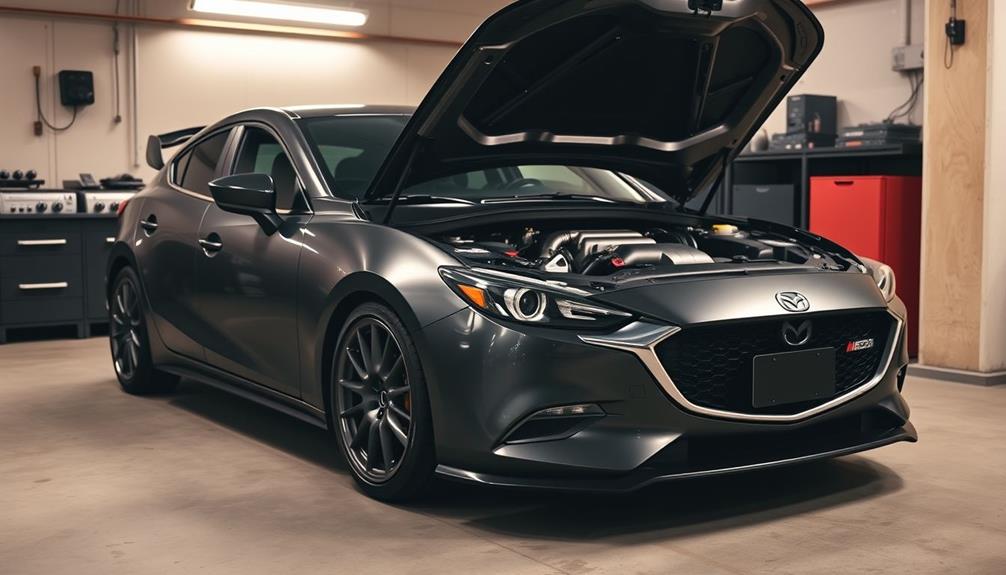
To truly release your Mazdaspeed3's potential, fundamental performance modifications are a must. Start with a high-flow air intake system; this upgrade considerably increases airflow and enhances throttle response, giving you a noticeable boost in power and acceleration.
Next, consider installing a performance exhaust system. This modification reduces back pressure, allows your turbocharged engine to breathe better, and can increase horsepower by 10-20 HP.
Don't forget about ECU tuning. After making major modifications, tuning your engine's control unit is essential. It adjusts fuel maps and ignition timing to unleash the full potential of your upgrades.
Additionally, high-performance intercoolers are fundamental; they effectively lower inlet temperatures, improving boost efficiency and preventing heat soak during spirited drives.
Lastly, suspension upgrades, such as coilovers or lowering springs, are critical for enhancing handling precision. These upgrades provide better stability and a more engaging driving experience on twisty roads.
Choosing the Right Tuning Tools

Selecting the right tuning tools can greatly impact your Mazdaspeed3's performance. One of the most efficient options available is the VersaTuner. This user-friendly tool allows you to flash your ECU in under an hour, even if you lack technical expertise. Its compatibility with OBD-II ports means you won't need to make any physical modifications to your vehicle.
Additionally, the VersaTuner offers throttle calibration updates, which can enhance throttle response and overall performance, especially when paired with aftermarket performance parts. If you're aiming to maximize your Mazdaspeed3's capabilities, proper ECU adjustments are essential following bolt-on modifications, as they can unleash an impressive 18-30 horsepower depending on your fuel octane.
| Feature | VersaTuner | Benefits |
|---|---|---|
| User-Friendliness | Yes | Easy for beginners |
| ECU Flash Time | < 1 Hour | Quick tuning process |
| Throttle Calibration | Yes | Improved throttle response |
| Professional Support | Yes (Pro Sub) | Advanced tuning options |
| Compatibility | OBD-II | No physical modifications needed |
Frequently Asked Questions
How to Increase Horsepower on Mazda3?
To increase horsepower on your Mazda3, upgrade the ECU with performance tunes, install a cold air intake, and high-flow exhaust. Regularly maintain air filters and consider throttle calibration for improved response and power gains.
Can You Boost a Mazda3?
Absolutely, you can turbocharge that Mazda3 and release a beast! With the right upgrades, like a cold air intake and performance exhaust, you'll feel the power surge, transforming your drive into an exhilarating experience.
How Much HP Does a Mazdaspeed3 Make?
A Mazdaspeed3 produces around 263 horsepower and 280 lb-ft of torque in stock form. With proper tuning and modifications, you can increase that to over 300 horsepower, revealing even more thrilling performance potential.
How Much Horsepower Does a Mazda3 Performance Have?
You'd think a Mazda3 can't impress, right? Well, the standard model packs 191 horsepower, while the turbo variant cranks it up to 250. With a few tweaks, you can release even more power!
Conclusion
In the grand race of automotive enthusiasm, tuning your Mazdaspeed3 is your golden ticket to a thrilling ride. With each modification, you're not just enhancing performance; you're crafting a personal masterpiece that echoes the spirit of legendary speed demons. By choosing the right tools and upgrades, you'll release the beast within, transforming your hatchback into a force to be reckoned with. So, buckle up and embrace the journey—your high-performance adventure is just beginning! When it comes to tuning your Mazdaspeed3, it’s important to do your research and seek out expert advice. With the right mazda 3 mps tuning tips, you can ensure that each modification is tailored to your specific goals and driving style. Whether it’s upgrading the exhaust system, fine-tuning the suspension, or increasing horsepower, the possibilities for unleashing the full potential of your Mazdaspeed3 are endless.
Alex is our go-to expert on performance tuning, with over a decade of experience in the automotive industry. His deep understanding of engine dynamics, exhaust systems, and performance software allows him to break down complex concepts into easy-to-follow guides. Whether you’re looking to boost horsepower or fine-tune your vehicle’s responsiveness, Alex’s insights will help you achieve peak performance.
Mazda Tuning
Mazda 3 Chip Tuning: Unlocking the Hidden Power of Your Compact Sedan
Navigate the world of Mazda 3 chip tuning to unleash hidden power and enhance performance—discover how to elevate your driving experience today!

Mazda 3 chip tuning releases your compact sedan's hidden power by enhancing performance in several key areas. You can expect a boost in horsepower by 20-40, along with improved throttle response and low-end torque for a smoother drive. The installation's a breeze thanks to the plug-and-play design, meaning no modifications are needed. You'll even optimize fuel efficiency by adjusting settings like VVT and ignition timing. Plus, engaging with the Mazda tuning community can provide tips and insights on your performance upgrades. Want to find out more about maximizing your Mazda 3's potential? There's plenty to explore.
Key Takeaways
- Chip tuning for the Mazda 3 can boost horsepower by 20-40, significantly enhancing acceleration and overall engine performance.
- Installation is straightforward with plug-and-play designs, requiring no modifications to your vehicle.
- Performance chips optimize fuel efficiency by adjusting VVT and ignition timing, improving both power and economy.
- Engaging with the Mazda tuning community provides valuable insights and support for maximizing your vehicle's performance.
- Dyno testing is recommended post-tuning to validate improvements and ensure compatibility with your Mazda 3.
Benefits of Chip Tuning
Chip tuning your Mazda 3 can transform your driving experience dramatically. By installing a performance chip, you can boost your horsepower by 20-40, which considerably enhances acceleration and overall engine performance.
With a properly tuned ECU, you'll notice improved low-end torque and throttle response, making your drives smoother and more exhilarating.
One of the best features of chip tuning is the plug-and-play design of many performance chip modules, like Stage 1 and Stage 2 options. These modules guarantee easy installation without the need for cutting or extensive modifications.
Tuning your engine releases hidden potential by adjusting essential parameters such as VVT and ignition timing, which optimizes fuel efficiency and performance under various driving conditions.
Many Mazda enthusiasts rave about the enhanced smoothness in gear shifts and consistent power output after chip tuning.
This modification not only delivers a thrilling driving experience but also enhances your Mazda's overall efficiency.
If you're looking to elevate your Mazda 3's engine performance and enjoy a more responsive ride, chip tuning is a smart choice that can make a remarkable difference.
Performance Enhancement Options

There are numerous performance enhancement options available for your Mazda 3 that can greatly elevate its capabilities.
One popular choice is the Stage 1 Performance Chip Module OBD2, priced at $99.99. This plug-and-play performance chip can increase your car's horsepower by 20-40, enhancing both acceleration and your overall driving experience without any cutting required.
If you're looking for more advanced features, higher-end tuning options, like the Stage 4 Module with an LCD monitor, offer deeper customization while still maintaining a money-back guarantee.
For those who've made modifications to their engines, ECU remapping can reveal additional horsepower, with some users reporting gains of 18-30 HP, especially when using premium fuel.
These tuning options cater to various performance needs, ensuring compatibility with both turbocharged and hybrid engines.
Whether you want a simple upgrade or an extensive tune, enhancing your Mazda 3's performance is achievable.
Each option focuses on optimizing your driving experience, allowing you to reveal the hidden power of your compact sedan.
Community Insights and Support
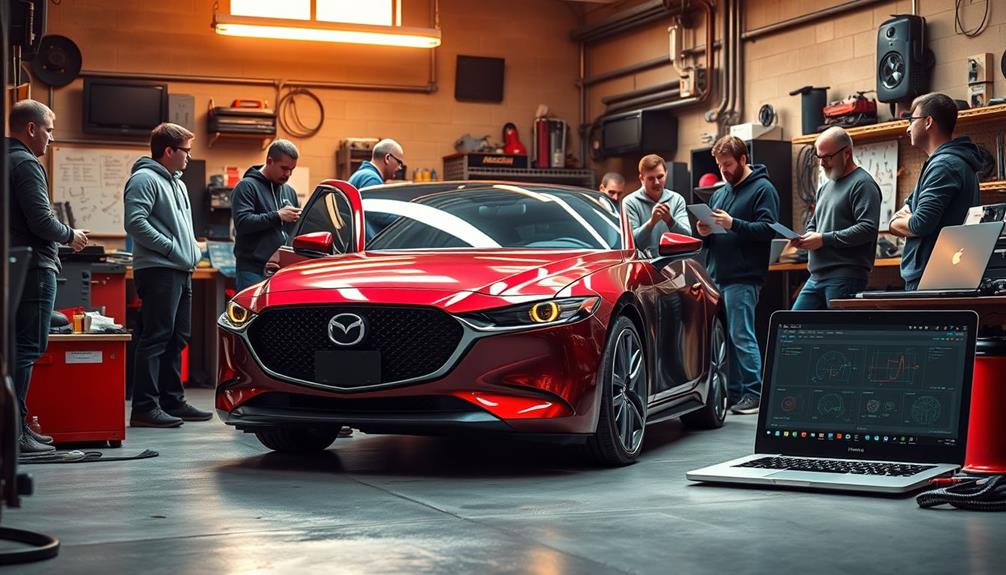
Tapping into the wealth of knowledge within the Mazda tuning community can greatly enhance your experience with performance modifications. By engaging with fellow enthusiasts, you'll discover valuable insights on performance chip modules that can markedly improve your Mazda 3's throttle response, horsepower, and torque.
Online forums and groups serve as excellent platforms where you can share experiences, discuss tuning options, and get installation tips tailored to your model.
User feedback is essential; many members highlight the tangible improvements they've noticed after implementing performance chips. It's wise to contemplate dyno testing to validate your modifications, ensuring they meet your performance expectations and are compatible with your specific setup.
Moreover, the community offers a plethora of tuning guides and troubleshooting support, fostering a collaborative environment for those keen to enhance their Mazda's performance.
Whether you're a novice or a seasoned tuner, tapping into these resources can help you make informed decisions and optimize your vehicle's capabilities. Embrace the connections you make, and enjoy the journey of revealing your Mazda 3's hidden power together with fellow enthusiasts!
Frequently Asked Questions
Can You Chip Tune a Mazda 3?
Yes, you can chip tune your Mazda 3. By using performance modules, you'll release extra horsepower and improve throttle response. Just make sure the chip's compatible with your specific model for the best results.
How to Increase Horsepower in Mazda 3?
Sure, you could just drive your Mazda 3 as is, but why settle for less? Boost horsepower by installing a performance chip, cold air intake, or tuning the ECU for a thrilling driving experience.
Can You Tune a Mazda?
Yes, you can tune a Mazda. By using performance chip modules or ECU reflashing, you'll boost horsepower and improve throttle response. It's a straightforward process that reveals your vehicle's hidden potential effectively.
What Is ECU in Mazda 3?
Think of the ECU as the brain of your Mazda 3. It controls engine performance by managing fuel injection and ignition timing, ensuring your ride runs efficiently while adapting to real-time conditions for peak performance.
Conclusion
In summary, chip tuning your Mazda 3 is like adding a turbocharger to your driving experience. You reveal hidden power, transforming your compact sedan into a responsive powerhouse. With performance enhancements tailored to your needs and a community ready to support you, you're not just upgrading your car; you're elevating your entire driving journey. So, why wait? Immerse yourself in the world of chip tuning and feel the difference on the road today!
Alex is our go-to expert on performance tuning, with over a decade of experience in the automotive industry. His deep understanding of engine dynamics, exhaust systems, and performance software allows him to break down complex concepts into easy-to-follow guides. Whether you’re looking to boost horsepower or fine-tune your vehicle’s responsiveness, Alex’s insights will help you achieve peak performance.
Mazda Tuning
Tuning Mazda Miata: Transforming Your Roadster Into a Track-Ready Machine
With expert tuning tips, discover how to transform your Mazda Miata into a track-ready machine that will leave you craving more speed and excitement.

Tuning your Mazda Miata is a thrilling way to enhance its capabilities and make it track-ready. Start with suspension upgrades, like adjustable coilovers and stiffer sway bars, to improve handling and stability. Next, boost your braking performance with high-performance pads and stainless steel lines. You'll also want to increase power through aftermarket intake and exhaust systems. Don't forget weight reduction by removing unnecessary components or using lighter materials. Finally, prioritize safety with a roll cage and racing harnesses. There's plenty of exciting modifications that can elevate your Miata even further, so stick around for in-depth tips and insights.
Key Takeaways
- Upgrade to adjustable coilovers for improved handling and lower center of gravity, enhancing cornering performance on the track.
- Install high-performance brake pads and slotted rotors to boost braking efficiency and heat dissipation during intense driving.
- Enhance power delivery with a performance intake and exhaust system, along with engine tuning for optimal horsepower and torque.
- Implement weight reduction techniques by removing non-essential components and using lightweight materials for better agility on the track.
- Equip your Miata with a roll cage and racing harnesses to improve safety and structural rigidity during high-speed maneuvers.
Suspension and Handling Upgrades
When it comes to improving your Mazda Miata's performance, suspension and handling upgrades are fundamental. Installing adjustable coilovers is one of the best ways to lower your MX-5's center of gravity, greatly enhancing handling and cornering performance, especially on the track.
Stiffer sway bars can further minimize body roll during cornering, giving you a more stable driving experience at high speeds.
You can also consider adding chassis bracing, like strut tower and underbody braces, to increase your vehicle's rigidity. This added stiffness leads to improved handling response, making your Miata more responsive to your inputs.
To achieve peak performance, fine-tuning your suspension settings for both street and track use is essential. This involves adjusting damping and ride height to suit your driving style and conditions.
Don't forget about regular alignment and corner balancing; these practices guarantee your Miata maintains balanced handling characteristics, which is crucial for achieving faster lap times.
With these suspension upgrades, you'll transform your Miata into a track-ready machine that delivers the thrill and precision you crave.
Brake System Enhancements

Upgrading your Mazda Miata's brake system is essential for enhancing both safety and performance, especially on the track. To maximize your braking capabilities, focus on key upgrades that improve stopping power and reliability.
- High-performance brake pads and slotted or drilled rotors greatly boost braking performance and heat dissipation, vital for track conditions.
- Stainless steel brake lines replace the stock rubber lines, improving pedal feel and responsiveness by reducing flex.
- High-temperature brake fluid, like DOT 4, prevents brake fade during intense driving sessions, ensuring consistent performance.
Additionally, consider installing brake cooling ducts to enhance airflow to your brakes. This reduces temperature buildup, improving overall braking efficiency.
Regularly inspect and maintain your brake components, including calipers and pads, to sustain reliability during track events.
Power and Drivetrain Modifications
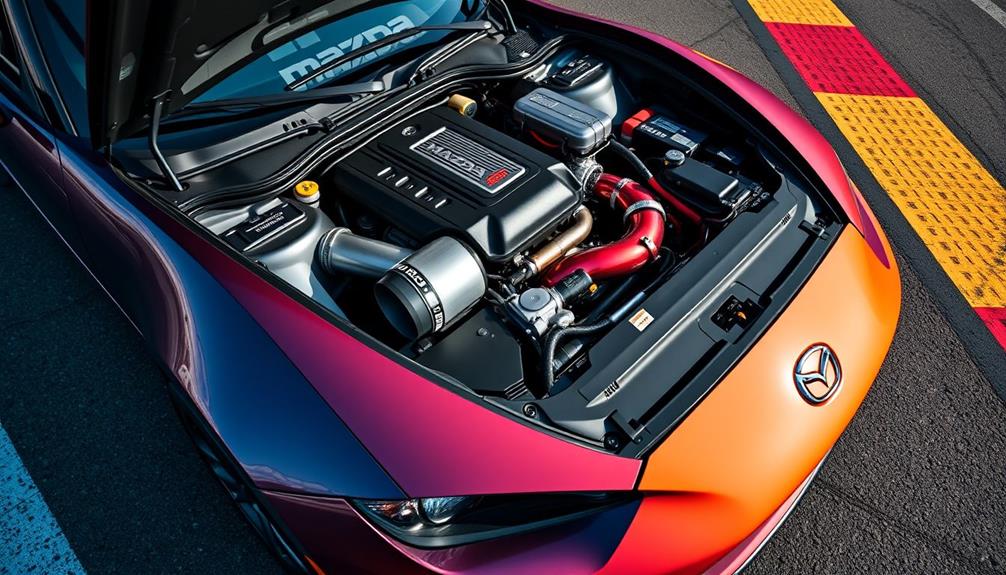
Maximizing your Mazda Miata's performance hinges on effective power and drivetrain modifications.
Start by upgrading the stock intake and exhaust systems with performance variants. This boosts airflow, leading to a noticeable increase in horsepower and torque. Pair this with a lightweight flywheel, which enhances engine responsiveness and acceleration, potentially giving you up to a 7 hp gain in lower gears.
Next, consider installing a limited-slip differential (LSD). This upgrade is essential for improving traction and stability during aggressive cornering on the track, allowing you to maintain control without sacrificing speed.
Regular tuning of your engine is also important; it optimizes power delivery and efficiency, ensuring your Miata performs at its best under varying conditions.
Weight Reduction Techniques

To enhance your Mazda Miata's performance, weight reduction is essential. By shedding excess pounds, you'll notice improved acceleration, handling, and cornering stability, making your Miata more track-ready.
Here are some effective techniques:
- Remove non-essential interior components: Stripping out rear seats and carpeting can greatly lighten your Mazda Miata MX, allowing for a more agile driving experience.
- Switch to lightweight materials: Replacing stock body panels with carbon fiber or fiberglass keeps structural integrity intact while cutting down on weight.
- Use a lightweight battery: Opt for a lithium-ion battery to shave off several pounds, further boosting performance.
In addition to these methods, consider utilizing minimalist racing components like racing seats and stripped-down dashboards.
This helps optimize your Miata's weight distribution, which is vital for better track preparation. Regularly assess and adjust the weight distribution to achieve balanced handling during high-speed maneuvers.
Safety Equipment Upgrades

Guaranteeing your safety on the track involves a series of essential upgrades that can make a significant difference in your driving experience.
Start with a roll cage, especially if you have a soft-top MX-5. It provides critical roll protection and enhances structural rigidity, which is fundamental in the event of a rollover.
Next, consider swapping out your stock seats for lightweight racing seats. These seats offer improved support and are designed to work seamlessly with racing harnesses.
Speaking of harnesses, installing racing harnesses is a must. They secure you more effectively during high-speed maneuvers, keeping you firmly in place and reducing the risk of injury.
You should also invest in a fire extinguisher or a fire suppression system, as this equipment is significant for safety in case of an emergency.
Lastly, don't forget about regular inspections of all your safety equipment. Helmets, harnesses, and other gear should comply with track regulations to guarantee they function properly when you need them most.
Frequently Asked Questions
How to Make a Miata Track Ready?
To make your Miata track ready, equip essential safety gear, upgrade brakes and tires, enhance suspension with coilovers, and consider data collection tools. These upgrades will greatly improve your performance and overall driving experience on track days.
Is Miata RF Allowed on Track?
They say, "Where there's a will, there's a way." Yes, the Miata RF's allowed on track, but check each track's safety regulations. You might need safety gear like a roll bar, helmet, or fire extinguisher.
Is Miata Good for Track?
Absolutely, the Miata's lightweight design and balanced chassis make it an excellent choice for the track. You'll enjoy its agility and responsiveness, especially when you invest in performance upgrades like suspension and tires for peak handling.
Is a Mazda Roadster the Same as a Miata?
Yes, a Mazda Roadster is fundamentally the same as a Miata. They share the same chassis, engine, and design. The differences lie mainly in branding and regional features, but both deliver an exhilarating driving experience.
Conclusion
By investing in suspension upgrades, enhancing your brakes, and boosting your Miata's power, you're not just creating a track-ready machine—you're transforming your entire driving experience. You might worry about comfort on the streets, but with the right tuning, you can enjoy a perfect balance of performance and daily drivability. Imagine this: zipping around corners with precision, feeling the rush of speed, all while knowing your Miata's ready to conquer the track whenever you are.
Alex is our go-to expert on performance tuning, with over a decade of experience in the automotive industry. His deep understanding of engine dynamics, exhaust systems, and performance software allows him to break down complex concepts into easy-to-follow guides. Whether you’re looking to boost horsepower or fine-tune your vehicle’s responsiveness, Alex’s insights will help you achieve peak performance.
Mazda Tuning
Mazda Protege 2000 Tuning: Maximizing Power and Efficiency in Your Compact Car
Get ready to unlock your 2000 Mazda Protege’s true potential with expert tuning tips that could drastically enhance both power and efficiency. Discover the secrets now!

Tuning your 2000 Mazda Protege can boost both power and efficiency, turning your compact car into an exciting machine. Start with basic upgrades like a cold air intake and high-flow exhaust, which can add 20-25 whp. Lightweight wheels and flywheels improve acceleration and throttle response, making your ride more engaging. For significant power gains, consider turbocharging, but be sure to invest in supporting modifications and a proper ECU reflash to optimize performance. Engaging with the automotive community will uncover valuable insights and tips for effective upgrades, revealing even more options for enhancing your Protege.
Key Takeaways
- Upgrade the cold air intake and high-flow exhaust system for a combined 20-25 whp increase and improved engine efficiency.
- Consider lightweight components such as flywheels and wheels to enhance throttle response and acceleration without significant investment.
- Reflash the ECU to optimize fuel and ignition maps, maximizing performance for naturally aspirated setups.
- Explore turbocharging options for substantial power gains, ensuring supporting mods for longevity and reliability.
- Engage with the automotive community for cost-effective upgrade tips and to share experiences on effective tuning strategies.
Overview of Tuning Options
When it comes to tuning your 2000 Mazda Protege, you've got several exciting options to boost performance and enhance your driving experience. One of the simplest ways to achieve a power increase is by making basic modifications like upgrading your intake and exhaust systems. These changes can deliver an impressive 20-25 wheel horsepower, giving your Protege a noticeable lift in performance.
If you're looking for quicker throttle response and improved acceleration, consider swapping out to a lightweight flywheel and wheels. Reducing rotational mass considerably enhances your car's responsiveness.
For those willing to dive deeper into tuning, turbocharging can offer substantial power gains, but it's often best to look at platforms like the Mazda Speed 3 or 6 for improved reliability.
Don't underestimate the importance of proper tuning. Reflashing the MP3 ECU can maximize the performance of your naturally aspirated setup, ensuring you get the best power delivery.
Key Performance Modifications

Key performance modifications can transform your 2000 Mazda Protege into a more exhilarating driving machine. One of the most effective upgrades you can make is enhancing the intake system. A cold air intake, for example, improves airflow, which can yield a noticeable increase in horsepower.
Pair this with a high-flow exhaust system, and you could see gains of 20-25 whp from improved engine efficiency.
Don't overlook lightweight components either. Installing lightweight wheels and a flywheel reduces overall vehicle weight and rotational mass, enhancing acceleration and throttle response.
Additionally, consider a performance ECU reflash, specifically the MP3 ECU. This adjustment optimizes fuel and ignition maps, offering significant performance improvements for naturally aspirated setups.
Lastly, adding headers promotes better exhaust flow, making it an essential modification for maximizing engine performance.
These basic bolt-on modifications aren't only cost-effective but can also lead to a more enjoyable driving experience. By focusing on these key performance modifications, you'll reveal the full potential of your Mazda Protege, making it a fun and responsive compact car on the road.
Understanding Forced Induction

Forced induction is a game-changer for boosting the performance of your 2000 Mazda Protege. By utilizing turbocharging, you can considerably increase your engine's power output, often offering better power per dollar compared to traditional modifications. However, choosing the right components is essential. Larger turbos, like the GT30 or GT35, can deliver impressive power but may introduce lag, affecting your car's drivability.
Here's a quick overview of key considerations for forced induction:
| Aspect | Details |
|---|---|
| Tuning | Important for ideal performance across the RPM range. |
| Component Selection | Larger turbos can boost power but may sacrifice low-end performance. |
| Supporting Mods | Upgraded intercoolers and fuel systems are critical for longevity. |
Cost-Effectiveness of Upgrades
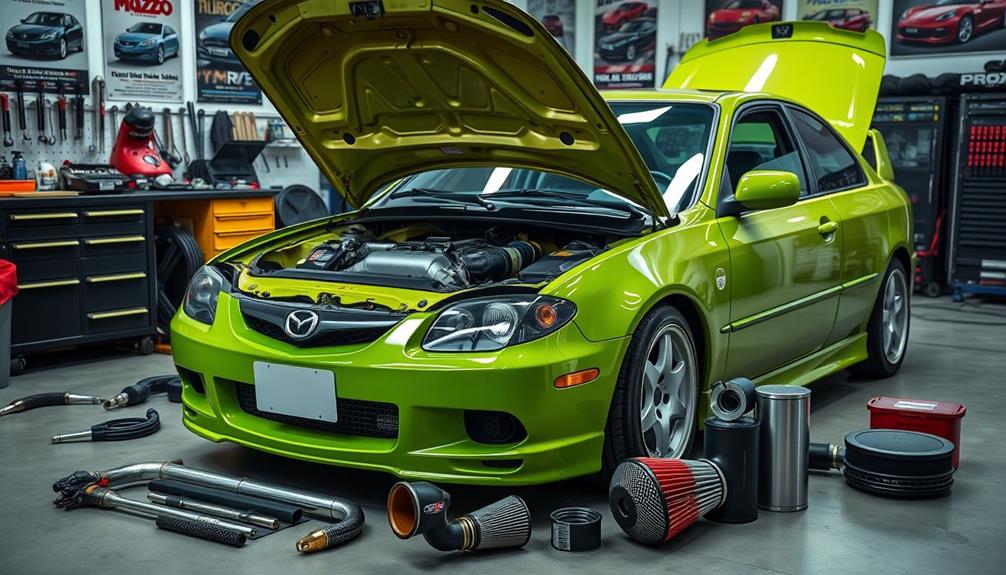
Upgrading your 2000 Mazda Protege can greatly enhance performance without breaking the bank. When considering the cost-effectiveness of upgrades, you'll find that incremental modifications, such as intake and exhaust upgrades, can provide around 20-25 whp gains at a minimal cost. These are some of the most cost-effective choices available.
You should also think about lightweight modifications, like lightweight wheels and flywheels. These can considerably improve acceleration and throttle response without requiring a hefty investment.
In contrast, while turbocharging offers substantial power increases, it typically demands an initial outlay of over $2500—making it less suitable for those on a tight budget.
Evaluating the cost-per-horsepower ratio is essential when deciding on upgrades. Forced induction often provides more power per dollar spent compared to naturally aspirated setups.
Keep in mind that engaging with the automotive community can provide valuable insights. By learning from others' experiences, you can identify practical, cost-effective tweaks that align spending with your performance goals.
Community Experiences and Tips

When tuning your Mazda Protege 2000, it's essential to gather insights from the community on common modifications and their performance impacts.
You'll find plenty of enthusiasts enthusiastic to share their experiences, whether it's about power gains or troubleshooting issues.
Engaging in these discussions can help you make informed decisions and avoid common pitfalls.
Common Modifications Insights
Many enthusiasts kick off their tuning journey for the 2000 Mazda Protege with basic bolt-on modifications like intake systems, headers, and exhausts. These upgrades can yield noticeable power gains of about 20-25 wheel horsepower (whp).
However, it's vital to guarantee proper installation and tuning; misalignment or incorrect settings can lead to performance issues and reduce efficiency.
Lightweight wheels and flywheels are also popular choices among the community. They greatly improve acceleration and throttle response, enhancing your overall driving experience.
If you're looking for more substantial performance improvements, consider an MP3 ECU reflash, which optimizes engine parameters for better power delivery in naturally aspirated setups.
Don't underestimate the value of engaging with the automotive community. Sharing experiences and recommendations can provide you with invaluable insights into effective mod combinations.
This connection can help you avoid pitfalls associated with aggressive modifications, guaranteeing a smoother tuning journey. By starting with the right modifications and leaning on community knowledge, you'll maximize both power and efficiency in your Mazda Protege.
Happy tuning!
Performance Gains Sharing
Sharing performance gains within the Mazda Protege community can really boost your tuning experience. Hearing from fellow enthusiasts can lead to valuable insights that enhance your car's performance.
Here are some tips that community members have shared:
- Intake, Header, and Exhaust Upgrades: Many report a power increase of 20-25 whp while keeping your car drivable.
- Address Vacuum Leaks: These can cause RPM instability, negatively impacting overall engine performance.
- Lightweight Wheels and Flywheel: Upgrading to these can considerably improve acceleration and throttle response, making your ride more enjoyable.
- Throttle Body Spacer: Installing one can optimize airflow, enhancing the efficiency of your other performance modifications.
Engaging with fellow modifiers in online forums is a great way to discover cost-effective upgrades that yield noticeable performance gains.
By sharing experiences and tips, you can refine your tuning process and achieve the best results for your Mazda Protege.
Don't hesitate to ask questions or share your findings; the community thrives on collaboration!
Troubleshooting Tips Exchange
Troubleshooting common issues in your Mazda Protege can be just as rewarding as discovering performance gains.
If you're experiencing low idle or engine RPM oscillation, the problem might lie in the throttle stop screw adjustments or vacuum leaks. Start by inspecting these areas thoroughly.
Using a scan tool to monitor the throttle position sensor (TPS) signal is highly recommended. Adjust the TPS for peak performance, and don't forget to clean the throttle body. This can enhance airflow and potentially resolve stalling issues, especially after you've corrected the throttle stop screw positions.
If you're still facing idle fluctuations, try disconnecting the battery for several minutes. This can reset the engine computer and may help stabilize your idle.
The community emphasizes understanding these adjustment processes, which can save you from overcharging at repair shops.
Engine Modification Strategies

When it comes to tuning your 2000 Mazda Protege, a few key engine modification strategies can greatly enhance performance.
By focusing on optimizing airflow and engine efficiency, you'll set the foundation for a powerful ride. Here are some effective modifications to contemplate:
- Upgrade the Intake and Exhaust Systems: Installing headers and straight piping can yield a power increase of about 20-25 whp.
- Adjust Cam Gears: Fine-tuning valve timing can maximize power delivery and overall engine performance, especially when paired with other upgrades.
- Install Lightweight Components: Switching to lighter wheels and flywheels reduces rotational mass, enhancing acceleration and throttle response.
- Reflash the ECU: A reflash of the MP3 ECU will markedly improve responsiveness and power output for naturally aspirated setups.
For even more performance, contemplate internal modifications like camshaft upgrades and ported cylinder heads.
Targeting a power goal of 180-200 hp at the crank will require these enhancements.
Enhancing Drivetrain Performance

To enhance your Mazda Protege's drivetrain performance, start by focusing on weight reduction strategies like lightweight wheels and a flywheel upgrade.
These modifications not only improve acceleration but also make your ride more responsive and fun.
Pairing a performance clutch with the right flywheel can optimize power transfer, giving you a more efficient driving experience.
Weight Reduction Strategies
The Mazda Protege 2000's performance can be dramatically enhanced through effective weight reduction strategies, particularly in the drivetrain. By shedding excess weight, you'll notice significant improvements in acceleration and throttle response.
Here are some key weight reduction strategies you can implement:
- Lightweight Wheels: Upgrade to lightweight alloy wheels to reduce unsprung mass, improving handling and acceleration.
- Lighter Flywheel: Swap out the stock flywheel for a lighter option, which enhances throttle response and reduces rotational mass.
- Remove Unnecessary Components: Take out rear seats or sound deadening material. You'll maintain essential comfort while decreasing overall weight.
- Racing Components: Invest in lightweight racing parts like aluminum control arms or a carbon fiber driveshaft to enhance handling and responsiveness.
Implementing these weight reduction strategies can yield performance gains equivalent to, or even greater than, traditional power-adding modifications.
Not only will you enjoy better acceleration, but you might also see improvements in fuel efficiency. By focusing on reducing weight, you're setting yourself up for an exhilarating driving experience with your Mazda Protege 2000.
Clutch and Flywheel Upgrades
Upgrading the clutch and flywheel in your Mazda Protege 2000 can considerably enhance drivetrain performance, transforming your driving experience. A lightweight flywheel can reduce rotational mass by 5-10 lbs, resulting in quicker throttle response and improved acceleration. This means you'll feel a noticeable difference when you press the gas pedal.
Pairing this with a performance clutch is vital. A performance clutch typically offers a torque capacity between 300-400 ft-lbs, allowing your vehicle to handle increased power from engine modifications without slipping. Opting for a clutch with a higher friction material will provide better grip, minimizing slippage during aggressive driving, and optimizing power transfer from the engine to the wheels.
However, it's essential to verify compatibility between your chosen clutch and flywheel weights. Mismatched weights can lead to vibrations and premature component failure, which can be frustrating and costly.
With the right pairing, you can expect a significant improvement in your acceleration times, often enhancing 0-60 mph performance by 0.2 to 0.5 seconds, depending on your overall setup. Upgrading your clutch and flywheel not only elevates performance but also elevates your entire driving experience.
Addressing Idle and RPM Issues
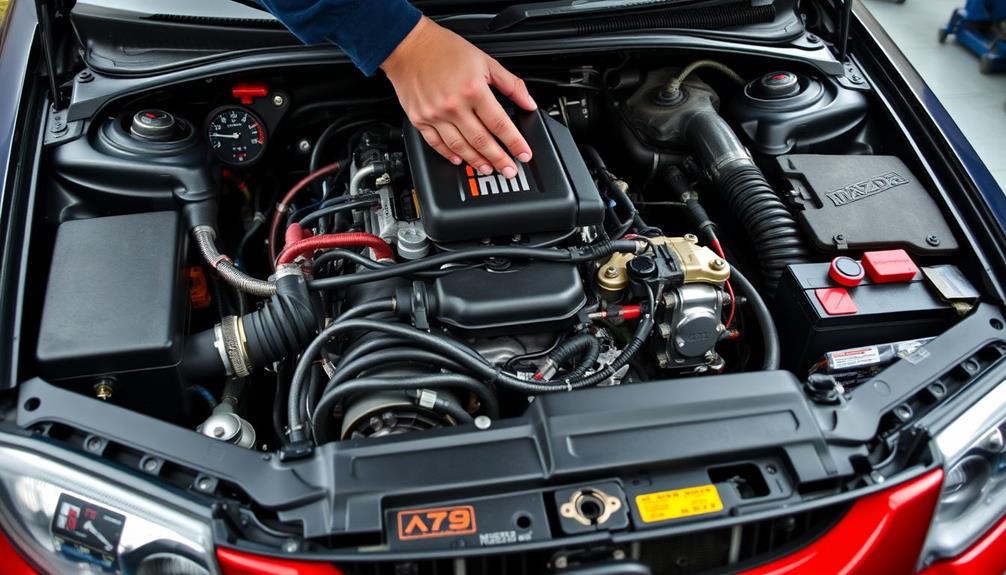
Idle and RPM issues in the 2000 Mazda Protege can be frustrating for drivers, often stemming from a variety of mechanical factors. These problems can manifest as low idle issues, RPM fluctuations, or even persistent cycling around 1850 RPM.
To tackle these issues effectively, consider the following steps:
- Throttle Stop Screw Adjustment: Confirm your throttle stop screw is properly adjusted to stabilize idle levels and minimize fluctuations between 1900 and 2500 RPM during acceleration.
- Throttle Position Sensor (TPS): If you've replaced the TPS but still face idle issues, don't rule out other potential culprits, such as vacuum leaks.
- Throttle Body Cleaning: Clean the throttle body after making adjustments. This helps confirm ideal airflow, contributing to improved idle stability.
- Reset the Engine Computer: Disconnecting the battery for a few minutes can reset the engine computer, which may resolve idle issues related to electronic adjustments.
Diagnosis and Repair Solutions

Addressing idle and RPM issues is just the first step in getting your 2000 Mazda Protege running smoothly. To diagnose low idle problems, start by adjusting the throttle stop screw and checking for vacuum leaks, which often cause RPM instability.
Using a scan tool to monitor the throttle position sensor (TPS) signal can pinpoint issues related to idle fluctuations effectively.
If you notice the check engine light on with trouble code PO-106, it's time to investigate the TPS and its related components further. Cleaning the throttle body is also essential after making any adjustments, as this improves airflow and guarantees your engine operates smoothly at idle speeds.
While you can tackle some of these steps yourself, professional assistance is advisable for repairs. Local shops equipped with advanced scanners can efficiently address idle issues, typically within an estimated labor time of one hour.
This not only saves you time but also ensures that any underlying problems are properly resolved, allowing you to enjoy peak performance from your 2000 Mazda Protege. Don't hesitate to seek expert help if you're unsure about any aspect of the diagnosis or repair process.
Expert Resources and Support
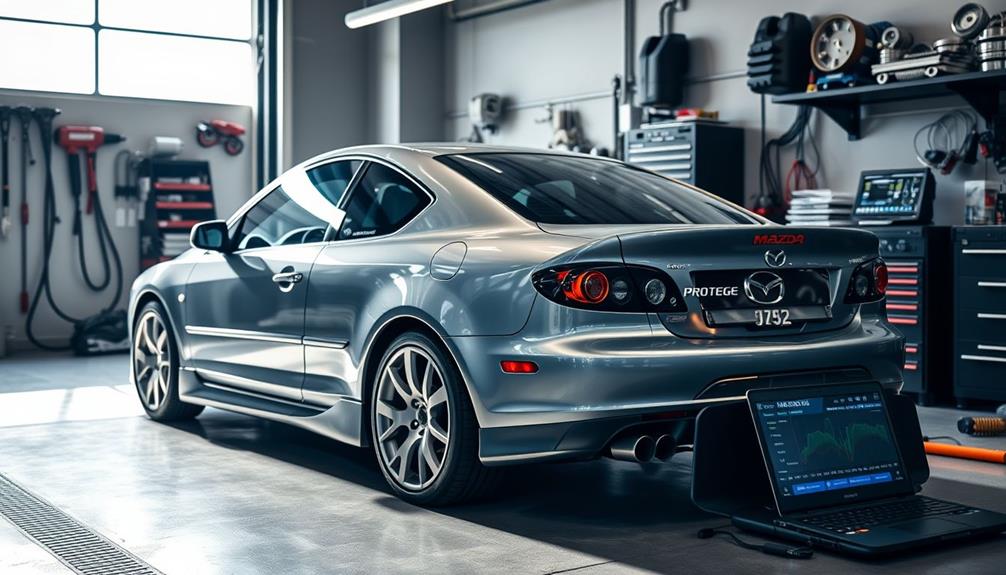
Finding expert resources and support can make all the difference when tuning your 2000 Mazda Protege. With the right guidance, you'll enhance your car's performance effectively. Here are some valuable resources to reflect upon:
- Automotive Experts: Gain access to over 12,000 verified automotive experts available 24/7 for tuning and performance inquiries. Their timely assistance can guide you through challenges.
- Community Forums: Engage with fellow Mazda enthusiasts through forums. You'll find practical insights and shared experiences about specific modifications that can enhance your Protege.
- Diagnostic Tools: Utilize scan tools to monitor performance metrics and troubleshoot issues. These expert resources will help you understand your car's needs during the tuning process.
- DIY Kits and Gear: Invest in port and polish sanding kits alongside protective gear. These essential resources empower you to tackle engine modifications hands-on, optimizing performance.
Frequently Asked Questions
How Many Miles Can a Mazda Protege Last?
A well-maintained Mazda Protege can last between 200,000 to 300,000 miles. By staying on top of regular maintenance, like oil changes and timely repairs, you can help your vehicle reach its maximum lifespan.
How Much Horsepower Does a Mazda Protege Engine Have?
The Mazda Protege's engine typically has around 120 horsepower at the crank. With modifications, you could boost this output to 140-150 horsepower, enhancing your car's performance and making your driving experience more enjoyable.
How Much Horsepower Does a 99 Mazda Protege Have?
The 1999 Mazda Protege offers a modest 105 horsepower from its 1.6-liter engine, or 130 with the 2.0-liter variant. You'll notice drivetrain losses can reduce that to about 80-90 horsepower at the wheels.
How Fast Is a Mazda Protege?
A Mazda Protege typically reaches a top speed of about 121 mph. With some tuning and modifications, you could potentially boost that speed closer to 140 mph, enhancing your driving experience considerably.
Conclusion
In the world of tuning your 2000 Mazda Protegé, think of your car as a blank canvas waiting for your artistic touch. With the right modifications, you can release a symphony of power and efficiency that'll make your heart race. Embrace the journey of upgrades, learn from fellow enthusiasts, and don't shy away from tackling challenges like idle issues. Immerse yourself, and watch your compact car transform into a thrilling ride that mirrors your personal style and passion. With endless possibilities at your disposal, consider starting with the essential Mazda Protege 2001 performance upgrades, such as a cold air intake, exhaust system improvements, or ECU tuning to optimize your engine output. Each adjustment brings you one step closer to creating a truly unique driving experience, allowing your vehicle to not only keep up with modern cars but also exceed expectations on the road.
Alex is our go-to expert on performance tuning, with over a decade of experience in the automotive industry. His deep understanding of engine dynamics, exhaust systems, and performance software allows him to break down complex concepts into easy-to-follow guides. Whether you’re looking to boost horsepower or fine-tune your vehicle’s responsiveness, Alex’s insights will help you achieve peak performance.
-

 Hybrid Tuning3 months ago
Hybrid Tuning3 months agoHonda Civic Hybrid Tuning: Unlocking Maximum Efficiency and Performance
-

 Hybrid Tuning3 months ago
Hybrid Tuning3 months agoPorsche Cayenne E-Hybrid Tuning: Unleashing the Beast Within the Luxury SUV
-

 Audi Tuning3 months ago
Audi Tuning3 months agoChip Tuning Audi: How to Unlock Extra Power Instantly
-

 Automotive DIY and Professional Guides3 months ago
Automotive DIY and Professional Guides3 months agoWhen Is Car Tuning Required? Signs It’s Time for an Upgrade
-

 Audi Tuning3 months ago
Audi Tuning3 months agoAudi A3 Tuning: Elevate Your Compact Car’s Performance
-

 Hybrid Tuning3 months ago
Hybrid Tuning3 months agoInfiniti Q50 Hybrid Chip Tuning: Enhance Performance With Precision Tuning
-

 Hybrid Tuning3 months ago
Hybrid Tuning3 months agoNissan Altima Hybrid Tuning: Upgrade Your Sedan for Maximum Efficiency
-

 Hybrid Tuning3 months ago
Hybrid Tuning3 months agoCube Reaction Hybrid Tuning: Get the Most Out of Your Electric Bike




























